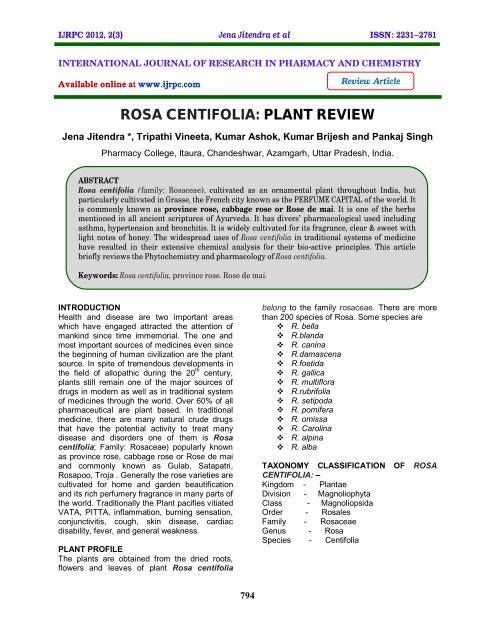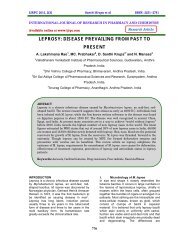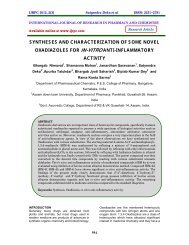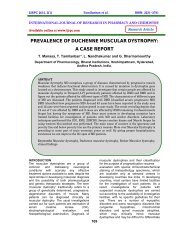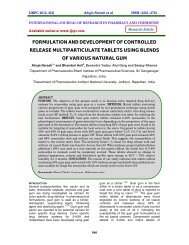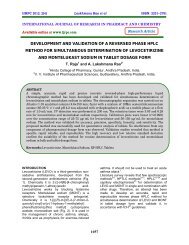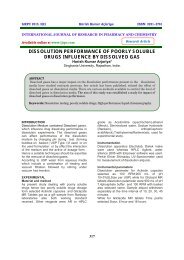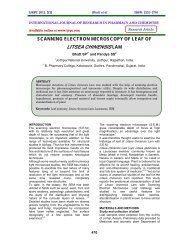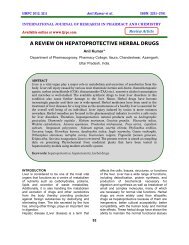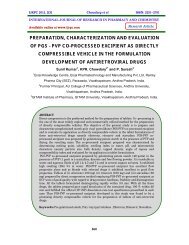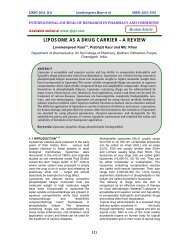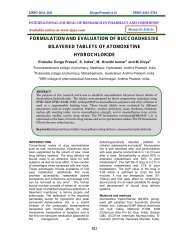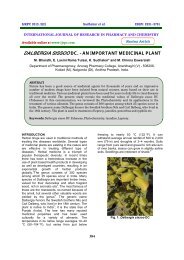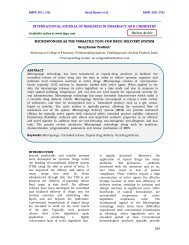ROSA CENTIFOLIA: PLANT REVIEW - ijrpc
ROSA CENTIFOLIA: PLANT REVIEW - ijrpc
ROSA CENTIFOLIA: PLANT REVIEW - ijrpc
Create successful ePaper yourself
Turn your PDF publications into a flip-book with our unique Google optimized e-Paper software.
IJRPC 2012, 2(3) Jena Jitendra et al ISSN: 2231�2781<br />
INTERNATIONAL JOURNAL OF RESEARCH IN PHARMACY AND CHEMISTRY<br />
Available online at www.<strong>ijrpc</strong>.com<br />
<strong>ROSA</strong> <strong>CENTIFOLIA</strong>: <strong>PLANT</strong> <strong>REVIEW</strong><br />
Jena Jitendra *, Tripathi Vineeta, Kumar Ashok, Kumar Brijesh and Pankaj Singh<br />
Pharmacy College, Itaura, Chandeshwar, Azamgarh, Uttar Pradesh, India.<br />
INTRODUCTION<br />
Health and disease are two important areas<br />
which have engaged attracted the attention of<br />
mankind since time immemorial. The one and<br />
most important sources of medicines even since<br />
the beginning of human civilization are the plant<br />
source. In spite of tremendous developments in<br />
the field of allopathic during the 20 th century,<br />
plants still remain one of the major sources of<br />
drugs in modern as well as in traditional system<br />
of medicines through the world. Over 60% of all<br />
pharmaceutical are plant based. In traditional<br />
medicine, there are many natural crude drugs<br />
that have the potential activity to treat many<br />
disease and disorders one of them is Rosa<br />
centifolia; Family: Rosaceae) popularly known<br />
as province rose, cabbage rose or Rose de mai<br />
and commonly known as Gulab, Satapatri,<br />
Rosapoo, Troja . Generally the rose varieties are<br />
cultivated for home and garden beautification<br />
and its rich perfumery fragrance in many parts of<br />
the world. Traditionally the Plant pacifies vitiated<br />
VATA, PITTA, inflammation, burning sensation,<br />
conjunctivitis, cough, skin disease, cardiac<br />
disability, fever, and general weakness.<br />
<strong>PLANT</strong> PROFILE<br />
The plants are obtained from the dried roots,<br />
flowers and leaves of plant Rosa centifolia<br />
794<br />
Review Article<br />
ABSTRACT<br />
Rosa centifolia (family: Rosaceae), cultivated as an ornamental plant throughout India, but<br />
particularly cultivated in Grasse, the French city known as the PERFUME CAPITAL of the world. It<br />
is commonly known as province rose, cabbage rose or Rose de mai. It is one of the herbs<br />
mentioned in all ancient scriptures of Ayurveda. It has divers’ pharmacological used including<br />
asthma, hypertension and bronchitis. It is widely cultivated for its fragrance, clear & sweet with<br />
light notes of honey. The widespread uses of Rosa centifolia in traditional systems of medicine<br />
have resulted in their extensive chemical analysis for their bio-active principles. This article<br />
briefly reviews the Phytochemistry and pharmacology of Rosa centifolia.<br />
Keywords: Rosa centifolia, province rose. Rose de mai.<br />
belong to the family rosaceae. There are more<br />
than 200 species of Rosa. Some species are<br />
� R. bella<br />
� R.blanda<br />
� R. canina<br />
� R.damascena<br />
� R.foetida<br />
� R. gallica<br />
� R. multiflora<br />
� R.rubrifolia<br />
� R. setipoda<br />
� R. pomifera<br />
� R. omissa<br />
� R. Carolina<br />
� R. alpina<br />
� R. alba<br />
TAXONOMY CLASSIFICATION OF <strong>ROSA</strong><br />
<strong>CENTIFOLIA</strong>: –<br />
Kingdom - Plantae<br />
Division - Magnoliophyta<br />
Class - Magnoliopsida<br />
Order - Rosales<br />
Family - Rosaceae<br />
Genus - Rosa<br />
Species - Centifolia
IJRPC 2012, 2(3) Jena Jitendra et al ISSN: 2231�2781<br />
CULTIVATION<br />
Rosa centifolia are particularly to the French city<br />
of Grasse known as the perfume capital of the<br />
world. It is widely cultivated for its fragrance. The<br />
flowers are commercially harvested for the<br />
production of rose oil, which is commonly used<br />
in perfumery. The plants cultivated are therefore<br />
recommended because of their higher flower<br />
production.<br />
MORPHOLOGY<br />
The plant is shrubby and grows up to 1.5-2<br />
meters in height. Leaves are grayish green in<br />
colour, compound, imperipinnate, with 5-7<br />
leaflets and the leaflets are ovate- lancelets.<br />
Flowers are varying in colour, usually pink,<br />
fragrant, with many petals. They are fleshy hip<br />
enclosing small and pendulous seeds. They are<br />
round shape, globular with their overlapping<br />
petals.<br />
CHEMICAL CONSTITUENTS<br />
The important chemical constituents isolated<br />
from flower petals by gas chromatographic<br />
analysis, were Phenyl ethanol (43%), Geranyl<br />
acetate (15.6%), Geraniol (10.5%), Linalool<br />
(6.9%), Benzyl alcohol (3.3%), Benzaldehyde<br />
(1.5%), Nerol (5-10%), Citronellyl acetate<br />
(0.3%).<br />
It also contains tannins, oloigomeric<br />
proantrocyanides, saccharine matter, mineral<br />
salts, salt of mallic acid & tartaric acid, Pectin<br />
(11%), Riboflavin, sugars, purgative glycosides<br />
(multiflorin A & B).<br />
USEFUL PART OF <strong>ROSA</strong> <strong>CENTIFOLIA</strong><br />
Generally the Leaves, Root, Flowers part are<br />
used.<br />
TRADITIONAL USE OF <strong>ROSA</strong> <strong>CENTIFOLIA</strong><br />
Traditionally the Plant pacifies vitiated VATA,<br />
PITTA, inflammation, burning sensation,<br />
conjunctivitis, cough, skin disease, cardiac<br />
disability, fever, and general weakness.<br />
Generally the several rose products are used to<br />
make different cosmetic preparation like creams,<br />
lotions and other cosmetic uses. It used for<br />
moisturizing purpose by mixing with vegetable<br />
glycerin. It was also used in toilet preparations,<br />
lozenges and toothpaste for its perfumery. Rose<br />
water is used in desserts, pastries and cakes.<br />
The flower buds are generally used in cardiac<br />
troubles and as a tonic and aperients. Gulkand<br />
made from the petals possesses mild laxative<br />
properties and is useful in sore throat and<br />
enlarged tonsils.<br />
795<br />
PHARMACOLOGICAL ASPECTS<br />
� The roots are useful in intestinal ulcers,<br />
rickets, hemorrhages and diarrhea and<br />
also astringent in nature.<br />
� The leaves are used in treating wounds,<br />
ophthalmia, hepatopathy and<br />
hemorrhoids.<br />
� The flowers has cooling emollient<br />
aromatic, cardio tonic, antiinflammatory,<br />
expectorant, aphrodisiac,<br />
depurative, febrifuge, intellect-promoting<br />
styptic, digestive, carminative,<br />
rejuvenating and tonic properties. It is<br />
also useful in asthma, high blood<br />
pressure, bronchitis, diarrhea,<br />
dysmenorrheal, cough, fever, fluid<br />
retention, insomnia, palpitation, and<br />
stress and urinary tract infections.<br />
� Tea made from petals used as- blood<br />
purifier, vertigo, and headache.<br />
� Mild sedative, local anesthetics,<br />
laxatives, liver protectors,<br />
antidepressant, cardio-active.<br />
� Rose petals are rejuvenating & prove to<br />
be a tonic.<br />
� Due to small and pleasant fragrance<br />
rose petals are used for making<br />
essential oils and perfumes.<br />
� Used as antioxidant, & antitussive.<br />
� It inhibits vasoconstriction.<br />
� It shows potent antibacterial activity.<br />
� It inhibits the growth of leukemia cell<br />
line<br />
� Ointment of rose-water<br />
It is commonly known as Cold Cream, enjoys<br />
deserved popularity as a soothing, cooling<br />
application for chapping of the hands, face,<br />
abrasions and other superficial lesions of the<br />
skin.<br />
BIOLOGICAL AND PHARMACOLOGICAL<br />
ACTIVITIES<br />
Antibacterial activity<br />
Hassan Ali et al, 2003 showed that Rosa<br />
centifolia water extract possesses significant<br />
antibacterial activity. It showed anti-microbial<br />
activity against bacterial strains like M.<br />
lysoditicus, S.aureus, C. pseudodiptheroid, S.<br />
dysenters, S. typhi, E. coli and S. pyogenes.<br />
Anti tussive activity<br />
Sankar et al,2011showed that the ethanol<br />
extract of Rosa centifolia produced significant<br />
anti-tussive activity. The essential oil obtained<br />
from Rosa centifolia is reported gastro
IJRPC 2012, 2(3) Jena Jitendra et al ISSN: 2231�2781<br />
intestinal relaxant activity; therefore the<br />
bronchodilatory effect is responsible for its antitussive<br />
property and might be due to its possible<br />
tachykinin inhibitory substance mediating antitussive<br />
effect.<br />
CONCLUSION<br />
Rosa centifolia have been ethno medicinally<br />
used as a therapeutic agent for a variety of<br />
diseases, as we have illustrated in this article.<br />
More ever, numerous research works have<br />
proven its uses beyond the ethno medicinal<br />
ones in experimental animals. Citronella &<br />
farnesol which were isolated from this plant may<br />
be responsible for these actions. Researchers<br />
are of the opinion that the presence of mallic<br />
acid and citric acid are the reason behind the<br />
laxative and diuretic effect.<br />
Leaves<br />
Flowers<br />
796<br />
Roots<br />
REFERENCES<br />
1. Hassan Ali; Nafisa; An investigation of<br />
antimicrobial compounds for<br />
immunomodulating and anti-adhesion<br />
properties, Pakistan Research<br />
Repository; 2003.<br />
2. K. Anu Kiruthika et al /Int.J. PharmTech<br />
Res.2011,3(2).<br />
3. M. Canales et al. / Journal of Ethno<br />
pharmacology 97 (2005) 429–439.<br />
4. M. KHALID SHABBIR ET AL., Pak. J.<br />
Bot., 41(2): 615-620, 2009.<br />
5. Nadkarni K. M.; Indian Material Medica,<br />
vol-1, page no-1071.<br />
6. Rastogi Ram P; Mehrotra B. N.;<br />
Compendium of Indian medicinal plant,<br />
volume-3rd (1980-1984) Page no:-554.<br />
7. Sankaranand R; Evaluation of antitussive<br />
activity of Rosa centifolia,<br />
IJPSR, 2011; Vol. 2(6). 1473-1475.<br />
8. The Wealth of India, vol-IX, page no-<br />
66-67.


